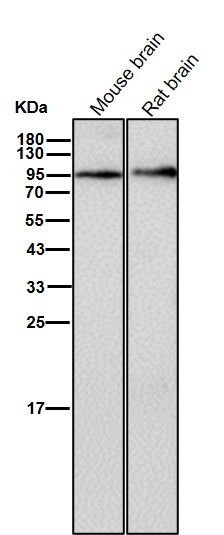


| WB | 1/1000-1/5000 | Human,Mouse,Rat |
| IF | 1/20-1/50 | Human,Mouse,Rat |
| IHC | IHC:1/100-1/200;IHF:1/50-1/200 | Human,Mouse,Rat |
| ICC | 1/50-1/200 | Human,Mouse,Rat |
| FCM | 1/20-1/100 | Human,Mouse,Rat |
| Elisa | 咨询技术 | Human,Mouse,Rat |
| Aliases | Glycogen [starch] synthase; Glycogen synthase 1 (muscle); Glycogen synthase 1; GSY; GYS; Gys1; muscle;;Glycogen synthase |
| WB Predicted band size | 84 kDa |
| Host/Isotype | Rabbit IgG |
| Antibody Type | Primary antibody |
| Storage | Store at 4°C short term. Aliquot and store at -20°C long term. Avoid freeze/thaw cycles. |
| Species Reactivity | Human,Mouse,Rat |
| Immunogen | A synthesized peptide derived from human Glycogen synthase |
| Formulation | Purified antibody in PBS with 0.05% sodium azide,0.05% BSA and 50% glycerol. |
+ +
以下是3篇关于Glycogen Synthase抗体的参考文献摘要(文献名称、作者及内容概括):
1. **"Antibodies directed against glycogen synthase phosphorylation sites as probes for insulin action"**
*作者:Cohen, P., et al. (1986)*
**摘要**:该研究开发了针对Glycogen Synthase磷酸化位点的多克隆抗体,用于检测胰岛素对酶活性的调控机制。抗体特异性识别不同磷酸化状态下的酶构象,证实胰岛素通过去磷酸化激活Glycogen Synthase。
2. **"Characterization of a monoclonal antibody specific to liver glycogen synthase"**
*作者:Bouskila, M., et al. (2010)*
**摘要**:文章描述了一种针对肝脏特异性Glycogen Synthase(GYS2)的单克隆抗体制备与验证,通过免疫印迹和免疫组化验证其特异性,并应用于研究肝糖原合成在糖尿病模型中的异常调控。
3. **"Role of glycogen synthase kinase-3 in insulin resistance and Wnt signaling"**
*作者:Lazarus, D.D., & Yamagami, K. (2004)*
**摘要**:尽管主要研究GSK-3(Glycogen Synthase Kinase-3),但文中使用针对Glycogen Synthase的抗体分析其磷酸化水平,揭示胰岛素信号通路中GSK-3对Glycogen Synthase活性的抑制作用及与胰岛素抵抗的关联。
---
提示:如需具体实验应用类文献,可进一步补充说明研究背景(如组织类型或疾病模型)。
Glycogen synthase (GS) antibodies are essential tools in studying the regulation of glycogen metabolism, a critical process in energy homeostasis. GS is the rate-limiting enzyme responsible for glycogen synthesis, catalyzing the transfer of glucose monomers from UDP-glucose to glycogen chains. Its activity is tightly regulated by phosphorylation-dephosphorylation mechanisms, primarily through insulin and glucagon signaling. Antibodies targeting GS enable researchers to detect and quantify its expression, post-translational modifications (e.g., phosphorylation at Ser641. Ser645), and subcellular localization in tissues like liver, muscle, and adipose.
These antibodies are widely used in metabolic research, particularly in diabetes, obesity, and glycogen storage diseases. Phospho-specific GS antibodies help assess its inactive (phosphorylated) vs. active (dephosphorylated) states, reflecting cellular energy status. Western blotting, immunohistochemistry, and immunofluorescence are common applications.
Commercial GS antibodies are typically raised in rabbits or mice against peptide sequences from human or rodent GS isoforms (GS1 in liver, GS2 in muscle). Validation includes knockout controls and activity correlation. Dysregulation of GS is linked to insulin resistance, making these antibodies valuable in exploring therapeutic targets for metabolic disorders.
×